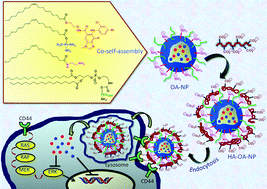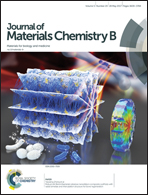Hyaluronic acid cloaked oleic acid nanoparticles inhibit MAPK signaling with sub-cellular DNA damage in colon cancer cells†
Abstract
RAS-RAF-MEK-ERK cascade in mitogen activated protein kinase (MAPK) signaling has been hijacked in colon cancer. However, the selective targeting of MAPK signaling components in colon cancer cells has remained a surmountable challenge. To address this, we have engineered hyaluronic acid cloaked 154 nm diameter oleic acid nanoparticles (HA-OA-NPs) comprising both an ERK inhibitor (AZD6244) and a DNA damaging drug (cisplatin). Dual drugs were slowly released from the HA-OA-NPs at an acidic pH (pH = 5.5) over 72 h. HCT-116 colon cancer cells engulfed these HA-OA-NPs by a CD44 receptor and clathrin-dependent endocytosis pathways followed by an accumulation into lysosomes over 6 h. These HA-OA-NPs inhibited the phosphorylation of extracellular signal-regulated kinases (ERK1 and ERK2) and damaged sub-cellular DNA to induce remarkable colon cancer cell (HCT-116 and DLD-1) death in contrast to a free drug cocktail at 24 h post incubation. Due to the biocompatibility and biodegradability of the nanoparticle components, the HA-OA-NPs could be brought into clinics as a platform for the synchronized inhibition of multiple targets for improved therapeutic efficacy in colon cancer patients.



 Please wait while we load your content...
Please wait while we load your content...